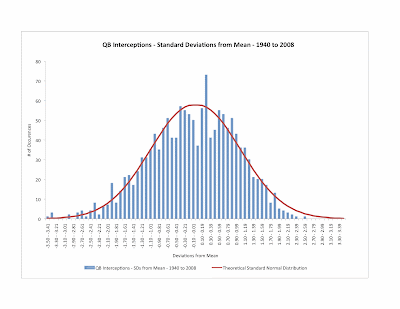 Philip Rivers of the San Diego Chargers had a phenomenal season in 2008. Or did he? According to the NFL's passer rating system, Rivers' season, where he completed 312 passes out of 478 attempted, threw for 4,009 yards, and 34 touchdowns against 11 interceptions resulted in a passer rating of 105.5. That's great, right? Before we answer that question, we'll need to answer a few more questions.
Philip Rivers of the San Diego Chargers had a phenomenal season in 2008. Or did he? According to the NFL's passer rating system, Rivers' season, where he completed 312 passes out of 478 attempted, threw for 4,009 yards, and 34 touchdowns against 11 interceptions resulted in a passer rating of 105.5. That's great, right? Before we answer that question, we'll need to answer a few more questions.How do the statistics 312 for 478, with 4,009 yards, 34 touchdowns and 11 interceptions translate to a rating of 105.5?
What does having a rating of 105.5 mean?
How has the average NFL passer rating changed over time, and how does that affect how we look at Rivers' season?
The NFL began keeping statistics in 1932. The NFL has used various methods to determine the "best" passer in the years since. According to the Pro Football Hall of Fame, the following is a chronology and description of the different methods used:
1932-1937: Total yards passing
1938-1940: Percentage of completions
1941-1948: Inverse ranking system of the following categories: completions, percentage of completions, total yards, total TD passes, number of interceptions, and percentage of interceptions
1949: The same formula used from 1941-1948 except the number of interceptions were dropped from the equation
1950-1959: Average yards gained per pass with a minimum of 100 attempts needed to qualify
1960-1961: Inverse ranking system based on six categories: total completions, total yards, total TD passes, percentage of completions, percentage of interceptions, average gain per attempt with the principle established of at least 10 attempts per game to qualify
1962-1971: Inverse ranking system based on four categories: percentage of completions, total touchdown passes, percentage of interceptions, average gain per attempt
1972: Same system used from 1962-1971 except that the percentage of touchdown passes was substituted for total touchdown passes
1973 to present: See below.
The passer rating system used by the NFL has been in place since 1973. In 1971, after the merger, then-commissioner Pete Rozelle wanted to implement a standardized set of statistics, including a standard measure of passing performance. As the description on the Hall of Fame site suggests, this is a measure of a quarterback's passing effectiveness, not a measure of how good a quarterback is. Rozelle called upon Don Smith, then an executive with the Hall of Fame, to work with the league's official statistician, the Elias Sports Bureau, to develop a new standard.
One of the problems with the standard that existed at the time, was that you didn't know where you stood until all the teams' quarterbacks had finished playing, as it was a relative ranking system. In addition, there wasn't a convenient way to compare a performance in a given year to that of another.
Don liked the use of the combination of statistics - in other words, the completion percentage, the yardage per attempt, the touchdown percentage and interception percentage. He had to figure out how to use all four in some manner that would make sense.
Working with the Elias Sports Bureau, he studied passing statistics for each of the four categories from the decade before - the sixties. After much study and thought, he devised a system whereby, for each of the four statistical measures, he would convert that particular measure to a "score" between 0 and 2. A score of 0 would indicate poor performance, a score of 1.00 would indicate "average" performance, and a score of 2.00 would indicate "superior" performance. With truly exceptional performance, it was possible to exceed a score of 2.00. He arbitrarily chose the maximum score to be 2.375.
He decided that an "average" performance across all four categories, that is, a score of 1.00 for each of the four measures, should be a rating of 66.7. Under this new rating system, it would be possible for a rating to exceed 100.0, but, he theorized that those instances would be rare.
(Note: I took a lot of this history from an article written by Don Steinberg, published in Slate magazine in 2001 - see here for the full article)
In summary then, this is how we end up with the current NFL passer rating system: we take four components of passing, convert each component, using league averages from the 1960's, to a score with a minimum of 0.000 and a maximum of 2.375, combine these scores by adding them, and convert to a rating system that has 66.7 as the "average".
Here's the math that does this:
Q = [ ( J + K + L + M ) * 100 ] / 6
where,
Q = Passer Rating
J = max [ min ( C, 2.375 ), 0 ]
K = max [ min ( Y, 2.375 ), 0 ]
L = max [ min ( T, 2.375 ), 0 ]
M = max [ min ( I, 2.375 ), 0 ]
and where,
C = [ ( Completions / Attempts ) * 100 - k1 ] / 20
Y = [ ( Yards / Attempts ) - k2 ] / 4
T = [ ( Touchdowns / Attempts ) * k3 ] * 20
I = 2.375 - [ ( Interceptions / Attempts ) * k4 ] * 25
and where,
k1 = 30
k2 = 3
k3 = 1
k4 = 1
In the first formula, you can easily see where if J = K = L = M = 1.000, the passer rating formula would yield Q = 66.7. In order to get J = K = L = M = 1.000, certain "transformations" were needed to each of the passing statistics to convert the averages to a score of 1.000. The transformations for each are shown as C, Y, T, and I, and, more specifically, k1, k2, k3 and k4. The figures for k1-k4 were derived using league statistics from the 1960's, and to make it somewhat easier, rounded. If you looked at data from 1960-1969, you get the following actual values for k1-k4:
k1 = 31.70
k2 = 3.24
k3 = 0.96
k4 = 0.99
The table below shows, for each NFL season from 1940-2008, how the averages, or, more precisely, the "scores" for those averages have changed from year to year (for a graphical illustration see my previous post on the subject here). For example, you can see that the average score for "J", in 2008 was 1.550, reflecting the fact that the "C" component, or, completions per attempt, for the average NFL quarterback was 61.0%. Compare this to the average score for "J" in 1968 of 1.079, reflecting the "C" component, or completions per attempt of that time of 51.6%. This is what happens when the transformations do not change over time, even when the actual game itself has undergone many transformations. If one wanted to keep everything in balance from year to year in the passer rating formula, in other words, to keep J = K = L = M = 1.000 for every year, then one would have to change the values of k1 - k4 every year. I have done that in the table below.
 You can use these different k values every year to "adjust" the passer rating formula, so that you can make meaningful comparisons from year to year. If you didn't do that, and simply compared a quarterback rating from one year to the next, you wouldn't get an appropriate comparison, for the simple reason that the four components would be "out of balance".
You can use these different k values every year to "adjust" the passer rating formula, so that you can make meaningful comparisons from year to year. If you didn't do that, and simply compared a quarterback rating from one year to the next, you wouldn't get an appropriate comparison, for the simple reason that the four components would be "out of balance". While it was never Don Smith's intention to have a relative measure of performance - he wanted performance as measured relative to a fixed standard, that "fixed" standard has changed, and will continue to change over time. One way to minimize the effect of these changes is to look at a given performance in a given year to that season's average, using the standard deviation as a measuring stick. The other way, is to simply "adjust" the standard to reflect the averages for that year. In a previous post, I discussed the former method. In this, I am obviously discussing the latter.
This discussion is only to put Rivers' 2008 season in perspective. It is not intended as passing judgment on the NFL passer rating system. I have, in previous posts (see here and here) discussed why I do not like the system. In a post in the future, I'll elaborate further on why I think the NFL's passer rating system should be revised.
The table below shows the 75 greatest seasons in the NFL, both in terms of the current NFL passer rating system, and using an "adjusted" passer rating system, going through the transformations as I have described above. You can see that, using the current system, that Rivers' 2008 ranks as 13th best all-time. Using an "adjusted" passer rating system, however, results in a ranking of 60th best all-time. If we used the previously mentioned standard deviations from mean measurement, it would rank as the 16th best all-time.
We still have some unfinished business:
How does Rivers' stats translate to a rating of 105.5?
He completed 312 of 478 passes, or, a completion percentage of 65.3% - using k1 = 30, and Comp/Att = 0.653 in the formulas above, yields a J value of 1.764
He threw for 4,009 yards, or, yards per attempt of 8.4 - using k2 = 2, and Yards/Att of 8.4, we get a value for K of 1.347
He threw 34 TDs, or, TD/Att of 7.1% - using k3 = 1, and TD/Att = 0.071, we get a value for L of 1.423
He threw 11 INTs, or, INT/Att of 2.3% - using k4 = 1, and INT/Att - 0.023, we get a value for M of 1.800
Combining all, we get
Q = ( J + K + L + M ) * 100 / 6, or
Q = ( 1.764 + 1.347 + 1.423 + 1.800 ) * 100 / 6 = 105.5
There is no doubt that, whether we use the current NFL passer rating system, an "adjusted" passer rating system with different transformations for different years, or, the current system, but adjusted by looking at standard deviations from the mean, that Rivers' 2008 season was quite remarkable.
Whether the passer rating system is an accurate reflection of a passer's ability is a completely different question altogether. We shall, over time, address this question.




























